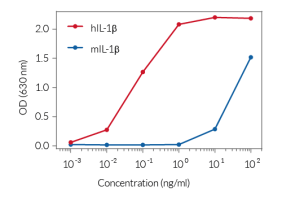Anti-hIL-1β-IgG
-
Cat.code:
mabg-hil1b-3
- Documents
ABOUT
Neutralizing monoclonal antibody against human interleukin 1 beta
Anti-hIL-1β-IgG (clone 4H5) is a monoclonal antibody (mAb) specific for human interleukin 1 beta (hIL-1β). It is produced in hybridomas and purified by affinity chromatography. This antibody has been selected for its ability to efficiently neutralize the biological activity of hIL-1β.
IL-1β is a soluble pro-inflammatory cytokine that plays a critical role in the host response to infection and injury [1].
Key features:
- A potent and specific neutralizing mAb against hIL-1β
- Provided azide-free
- No cross-reactivity with human IL-1α, murine IL-1α, or murine IL-1β
- Each lot is functionally tested
Reference:
1. Dinarello C., 2018. Overview of the IL-1 family in innate inflammation and acquired immunity. Immunol Rev. 281(1): 8–27.
All products are for research use only, and not for human or veterinary use.
SPECIFICATIONS
Specifications
IL-1β
Human
Sodium phosphate buffer, glycine, saccharose, stabilizing agents
Negative (tested using EndotoxDetect™ assay)
Neutralization assay
Each lot is functionally tested and validated.
CONTENTS
Contents
-
Product:Anti-hIL-1β-IgG
-
Cat code:mabg-hil1b-3
-
Quantity:3 x 100 µg
Shipping & Storage
- Shipping method: Room temperature
- -20 °C
- Avoid repeated freeze-thaw cycles
Storage:
Caution:
Details
Interleukin-1 beta (IL-1β) is a secreted pro-inflammatory cytokine [1]. It participates in the generation of systemic and local responses to infection and injury [2]. IL-1β is produced by activated macrophages as a pro‑protein, which is cleaved by caspase 1, an enzyme that is activated within the inflammasome multiprotein complex [3].
The resulting mature IL-1β is secreted and binds to the IL-1RI receptor triggering the formation of the IL-1R1/IL-1R3/MyD88 complex and inducing MyD88‑mediated intracellular signaling. This leads to the activation of the transcription factor NK-κB signaling, and the JNK and p38 mitogen‑activated protein kinase pathways, which induce the expression of inflammatory cytokines and chemokines, such as IL-6 and IL-8 [4].
1. Dinarello C., 2018. Overview of the IL-1 family in innate inflammation and acquired immunity. Immunol Rev. 281(1): 8-27.
2. Sims J. & Smith D., 2010. The IL-1 family: regulators of immunity. Nat Rev Immunol. 10(2):89-102.
3. O’Neill L., 2008. The interleukin-1 receptor/Toll-like receptor superfamily: 10 years of progress. Immunol. Rev. 226:10–18.
4. Weber A. et al., 2010. Interleukin-1 (IL-1) pathway. Sci Signal. 3(105):cm1.
DOCUMENTS
Documents
Technical Data Sheet
Safety Data Sheet
Validation Data Sheet
Certificate of analysis
Need a CoA ?





